Rob Mills is no stranger to executing on the frontlines of major technology shifts. In the run up to the pandemic, the technology lead for Tractor Supply Company had already cast significant bets on disaster recovery readiness and cutting-edge digital commerce and delivery capabilities, ensuring the retailer was well positioned during and in the aftermath of the COVID period.
[ Download the State of the CIO Research here. ]
Now with the focus on AI, Tractor Supply is once again capitalizing on its early adopter position thanks to longtime investments in AI for sales and merchandise forecasting and for optimizing replenishment of goods. More recently, Tractor Supply rolled out generative AI to build knowledgebases that drive insights aimed at personalizing and enhancing the customer experience and for analyzing team member performance. Next in queue is exploration of agentic AI applications to automate core processes.
Mills has navigated these critical digital inflection points as a strategic business leader, leading the organizational push to identify new uses, advocating for emerging technologies, and serving in a change agent capacity. In this latest AI chapter, Mills and his fellow CIOs are adding another strategic role to their already full charter: Educator and expectation setter as they help business leaders and employees fully understand AI’s potential while balancing soaring hype with the reality of where and how the technology can impact the business.
“Our job is to think about technology and introduce technology, but we’re really here to solve business challenges,” says Mills, executive vice president and chief technology, digital, and corporate strategy officer for Tractor Supply. “We need to train the organization to leverage AI to solve business problems, not just to create something new. We start with an AI mindset first and get the organization thinking differently about solving and architecting systems and processes.”

Rob Mills, chief technology, digital commerce and strategy officer, Tractor Supply
Rob Mills / Tractor Supply Co.
Charting a strategic AI course
There’s little question that AI has captivated audiences from the C-suite and board of directors down to line-of-business (LOB) users. Yet despite rising enthusiasm and heady expectations, AI experience and maturity levels remain nascent, opening the door for leadership that can chart a strategic course and help cut through the noise.
CIOs are well positioned to take up that charge, marshalling their tech-centric, business orientation to sketch out roadmaps, define deployment plans, and orchestrate change management strategies designed to drive success in what could be a make-or-break AI moment.
CIO.com’s 24th annual 2025 State of the CIO research, which surveyed 906 IT leaders and 250 LOB professionals, confirms IT leaders are ramping up their strategic focus this year, in part to convert early AI experimentation into initiatives that deliver measurable business results. In this year’s survey, 41% of IT leader respondents characterized their role as strategic compared to only 35% in 2024. More than half (52%) of this year’s respondents anticipate their strategic orientation will continue over the next three to five years. In comparison, 32% of IT leaders surveyed expect a swing back to more transformational work in that same timeframe while only 16% anticipate devoting significant time to more traditional and non-strategic IT duties.
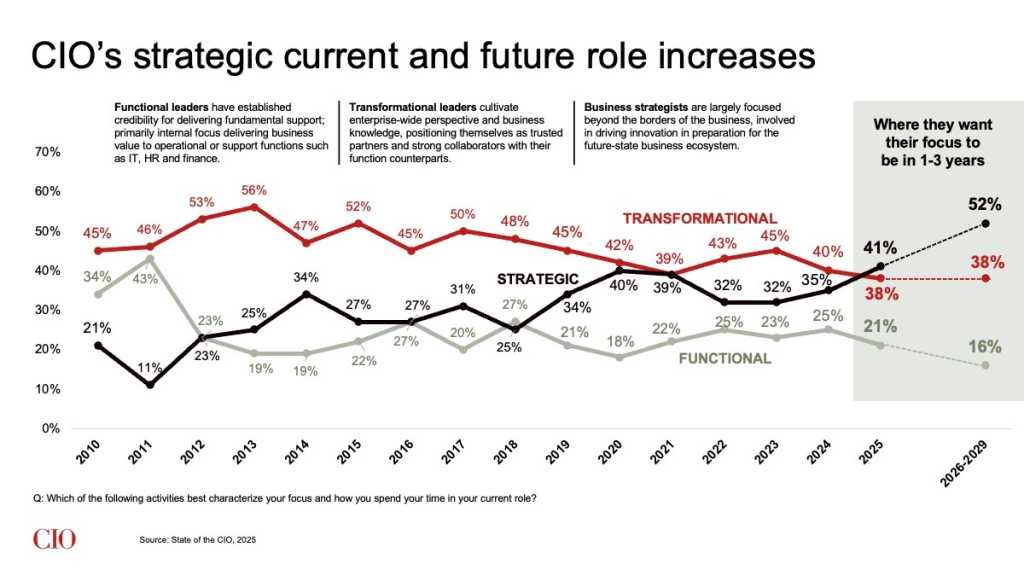
CIO.com
“The CIO role is expanding significantly in terms of helping the organization understand not just AI strategy, but AI as business strategy,” says Vikram Nafde, executive vice president and CIO at Webster Bank. “They are also leading the charge educating the board and making sure everyone understands what this all means.”
Navigating the AI and machine learning journey will become an even bigger focus for IT leaders over the next year, according to three quarters of IT leader respondents. Direction is being set by the executive suite. This year’s top CEO priority for IT leaders is researching and implementing AI products and projects, cited by 26% of State of the CIO respondents. In 2024, AI didn’t make the first cut as CEOs directed IT leadership to prioritize digital transformation initiatives, fortifying IT and business collaboration, and upleveling security to reduce corporate risk.

Vikram Nafde, EVP and CIO, Webster Bank
Webster Bank
As companies advance their AI agendas, they are doing so through partnership between IT and line of business. Three quarters of 2025 State of the CIO respondents said the CIO is collaborating closely with LOB leaders to strategize and develop AI applications. IT departments are also leaning on their business counterparts to drive AI adoption, cited by 71% of companies participating in this year’s research.
Oshkosh Corp. has numerous efforts under way to build a collaborative bridge between IT and the business, according to Anupam Khare, the company’s CIO. As part of a CEO-inspired movement to promote digital savviness, Oshkosh is working with select business users to identify problems, create solutions, and serve as ambassadors to influence others to get onboard. Khare has also staffed IT with people who have expertise in specific areas of the business — the shop floor, legal, or supply chain, for example — to create greater synergy and understanding of AI as well as general IT initiatives.
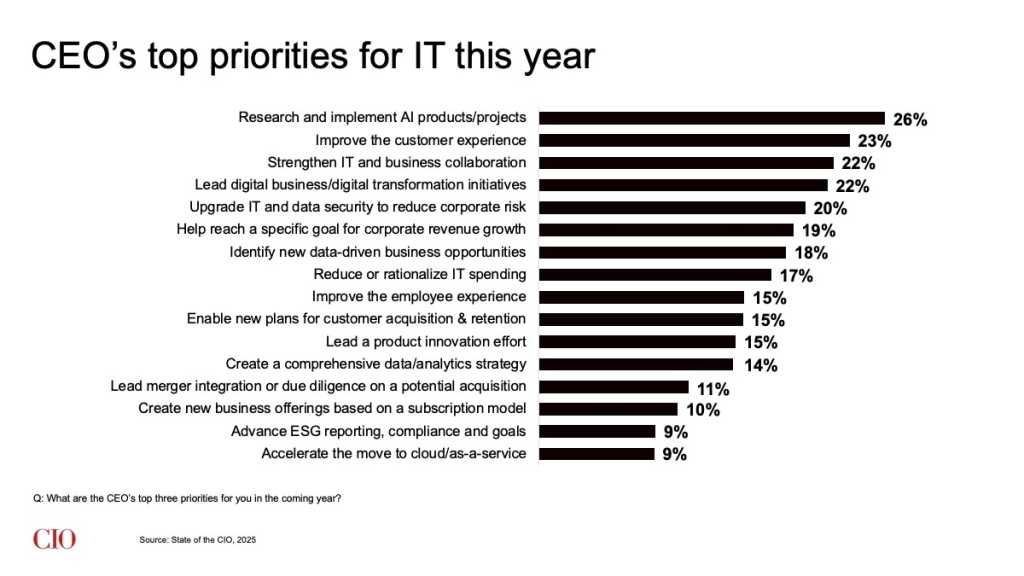
CIO.com
“We identified people who don’t know IT, but understand how to apply technology,” Khare explains. “We work with them to solve their problem and make them heroes. Once they communicate the message across the organization, it has a contagious effect.”
Even with a collaborative, business-oriented approach such as Oshkosh’s, CIOs still take the lead on the technology aspects of AI implementations. According to this year’s research, 80% of IT leaders said the CIO is spearheading efforts to research and evaluate possible AI additions to the tech stack; however, technology and business leadership are aligned on how to prioritize and direct those investments, with 68% of IT leaders and 69% of LOB respondents saying they were in sync on generative AI adoption strategies and use cases.

Anu Khare, senior vice president and CIO, Oshkosh Corp.
Anu Khare / Oshkosh Corp.
From experimentation to business impact
Reimaging internal business processes is one such key use case — so too is revamping the customer experience. Sixty-nine percent of IT leaders said they were leveraging AI to automate internal processes with the goal of streamlining operations and creating efficiencies, while 62% are embracing AI for customer-facing applications.
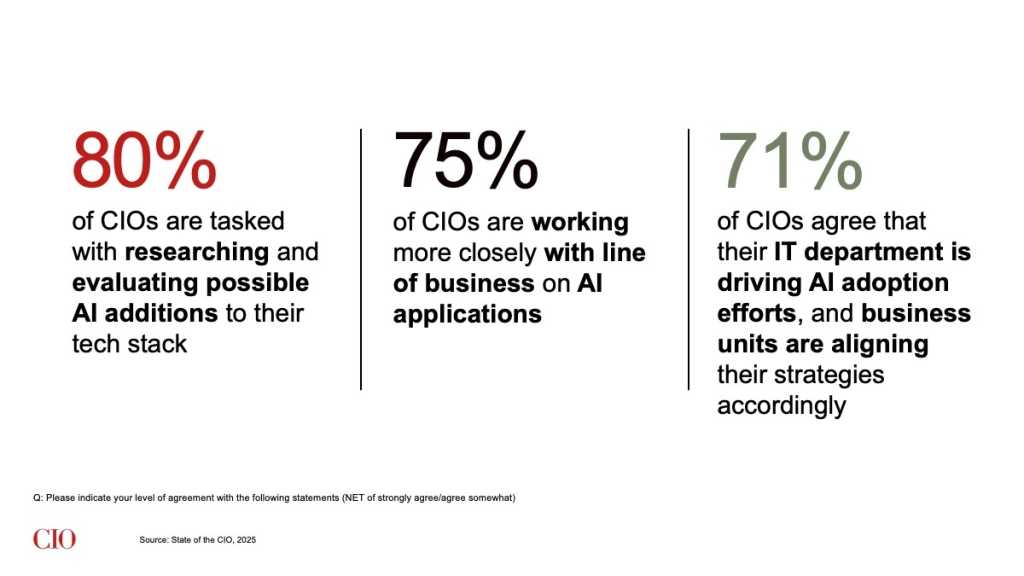
CIO.com
Regardless of how it’s applied, AI is already having an impact: More than two-thirds (68%) of IT leaders say AI has reshaped operations in some capacity and is driving tangible business outcomes.
Tractor Supply’s Hey GURA is an example of how AI technologies are being leveraged to improve the customer experience. The Siri-like assistant combines generative AI capabilities with mobile headsets to create a knowledgebase, sales, and training platform that helps employees better assist customers shopping for merchandise. Employees can use their device to ask voice-activated questions to find relevant products, make recommendations, or answer questions on product specs.
“Customers come in and want to know how to get their chickens to lay more eggs, and the team member may not have chickens,” Mills explains. “Hey GURA will come back with three recommendations for products or actions to take. We hear from team members that Hey GURA enables them to have deeper confidence [in product knowledge] at a faster rate.”
For internal-facing operations, Tractor Supply is applying LLMs to drive insights into team member performance and for real-time sales analysis. The retailer is also starting work on agentic AI applications to automate core business processes such as help desk tickets and updating and publishing content for new SKUs, Mills says. “Before someone would have to write content, take a photo, and publish in a system,” he adds. “Now we can automate that entire process in seconds.”
Under Khare’s direction, Oshkosh has categorized AI use into four buckets: Automation of human tasks; machine and human interaction; predictive and prescriptive analytics; and content generation and summarization. To date, the firm has achieved milestones in each of these areas. Among them: 300,000 hours of automation achieved across its entire value chain; success leveraging AI/ML for monitoring product defects during production; deployment of 205 predictive analytics solutions; and roughly 15 to 20 use cases for generative AI, including a tool that helps technicians easily find answers and get guidance when performing truck inspections.
“We’re not applying technology for technology’s sake,” Khare says. “We’re improving knowledge of our shop floor personnel and businesspeople so they can solve problems.”
The CIO agenda beyond AI
While AI/ML is by far the most prominent agenda item for 2025, there are plenty of other technology and business initiatives taking shape. This year, the bulk of technology spend is aimed at strategic business initiatives intended to fuel revenue growth and nurture customers. For instance, monetizing company data was the top business imperative for 38% of 2025 respondents, followed by improving the customer experience (35%) and developing new digital revenue streams (32%). Meeting compliance requirements also topped the list, cited by 35% of respondents.
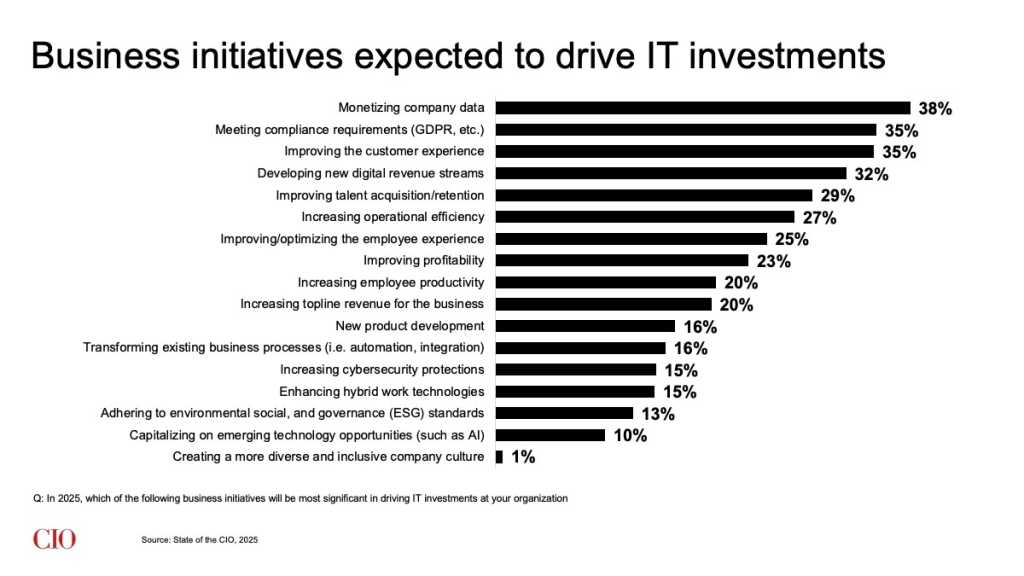
CIO.com
AI/ML is the technology initiative likely to be driving the most IT investment this year, cited by 42% of CIOs, and it was deemed the most strategically important, cited by 45%. Outside of AI/ML, companies are directing more dollars to security and risk management technologies (34%) and data/business analytics (31%).
Pacific Northwest National Laboratory (PNNL) is leveraging AI to streamline and enhance its software development process, including writing user stories and generating code. AI is also being tapped to develop synthetic data for testing and to help create user documentation.
The CIO’s role in all this is to lead the organization through imagining the art of the possible, explains Brian Abrahamson, PNNL’s associate laboratory director and chief digital officer for computing and IT. “We work alongside business leaders and executives to reimagine what’s possible,” he explains. “We are also reskilling and retooling to deliver and embed AI into their solutions.”

Brian Abrahamson, associate laboratory director and CDO, Pacific Northwest National Laboratory
Pacific Northwest National Laboratory
PNNL also continues to modernize IT architecture and infrastructure in the cloud and make ongoing cybersecurity investments — objectives shared by many 2025 State of the CIO respondents. This year’s research found CIOs spending time mapping out modernization strategies for infrastructure and applications (32%), ensuring IT initiatives are aligned with key business goals (31%), and redesigning business processes (26%). Leading change efforts was also part of the mandate, cited by a quarter of respondents.
With CIOs well settled in a strategic business role, it makes sense they are spending more time on strategy work this year. Driving business innovation (27%), developing and refining business strategy (27%), and studying market trends and customer needs (22%) constitute a large part of the CIO remit. CIOs plan to spend more time on AI/ML-related initiatives, at 75%, followed by cybersecurity (65%), product development and innovation (56%), and data analysis (56%).
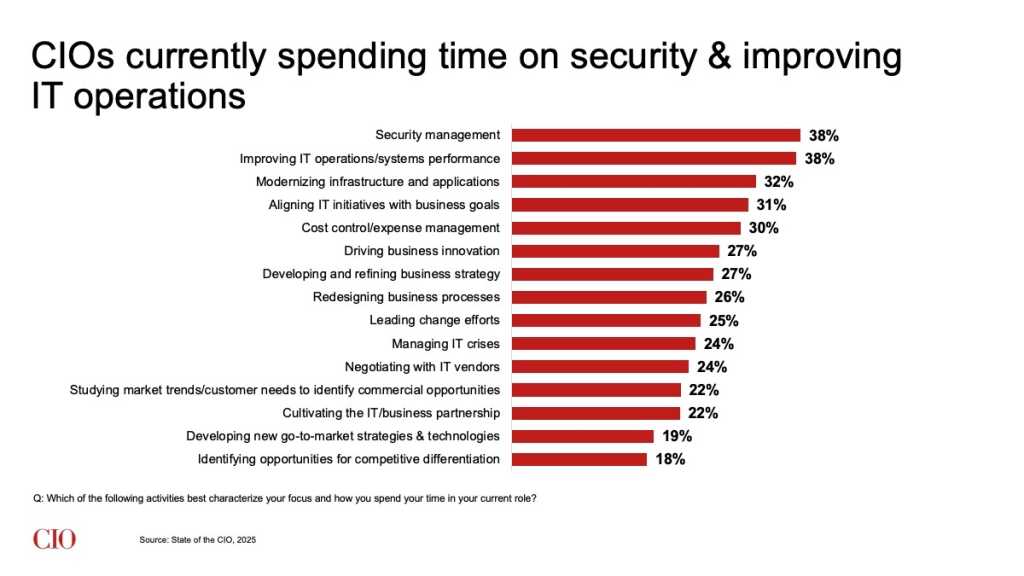
CIO.com
Even with a strategic focus, CIOs aren’t leaving functional and transformational duties behind. Thirty-eight percent of IT leaders confirmed they devote time to managing security and improving IT operations and systems performance. CIOs are also devoting bandwidth to mapping out modernization strategies for infrastructure and applications (32%), ensuring IT initiatives are aligned with key business goals (31%), and redesigning business processes (26%).
Talent challenges remain while IT budgets stay strong
Despite global business uncertainty, few companies are pulling back on technology investments. Sixty-five percent of respondents to the 2025 State of the CIO survey are anticipating IT funding increases while roughly a quarter (24%) expect funding to remain the same. On average, respondents expect a 6.9% bump in IT spending in 2025. Those planning to dole out more on IT expenditures correlate increases to the need to boost investments in AI/ML projects, products, and services, cited by 31% of respondents.
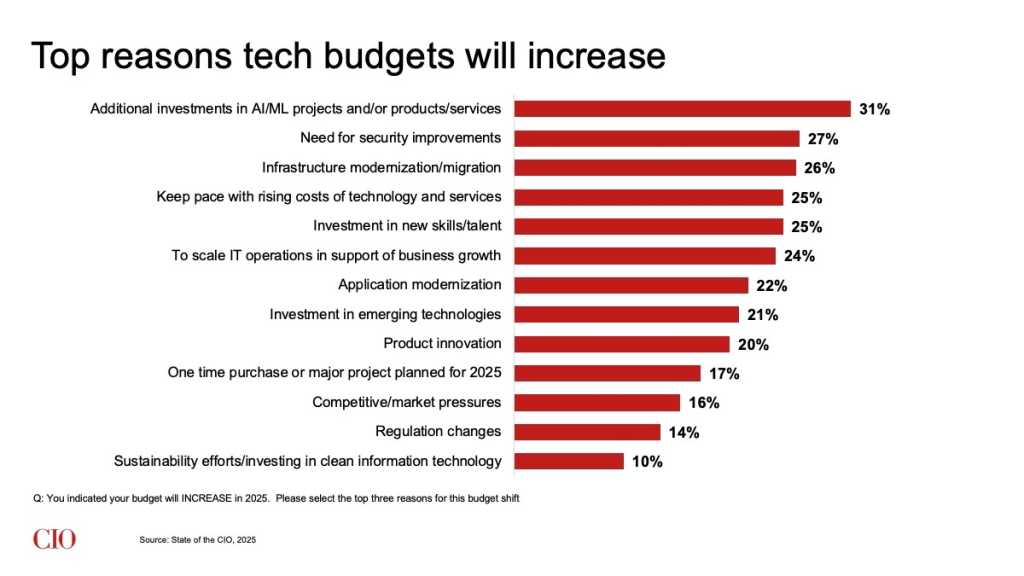
CIO.com
Staffing and talent issues remain a factor, especially for companies seeking to uplevel AI and machine learning expertise. Thirty-six percent of this year’s respondents plan to ramp up AI/ML hires in the next six to 12 months, while 34% are looking to add talent versed in cybersecurity and 25% in business/IT automation. Many expect trouble finding the right candidates, particularly in areas such as AI/ML (38%), cybersecurity (33%), and data science/analytics (21%).
“To focus the IT organization on value creation for the business, the fundamentals have to be in place, the tech stack modernized, and cybersecurity strong,” says Oshkosh’s Khare. “We also have to preserve our people who are bilingual, who understand both the business and technology.”
Dealing with staffing and talent issues is affecting CIOs’ ability to double down on strategic and innovation objectives, according to more than half of this year’s respondents (54%). Also in the way of higher-value, strategic work: Addressing changing business conditions (43%) and mitigating security threats (33%), according to this year’s respondents.
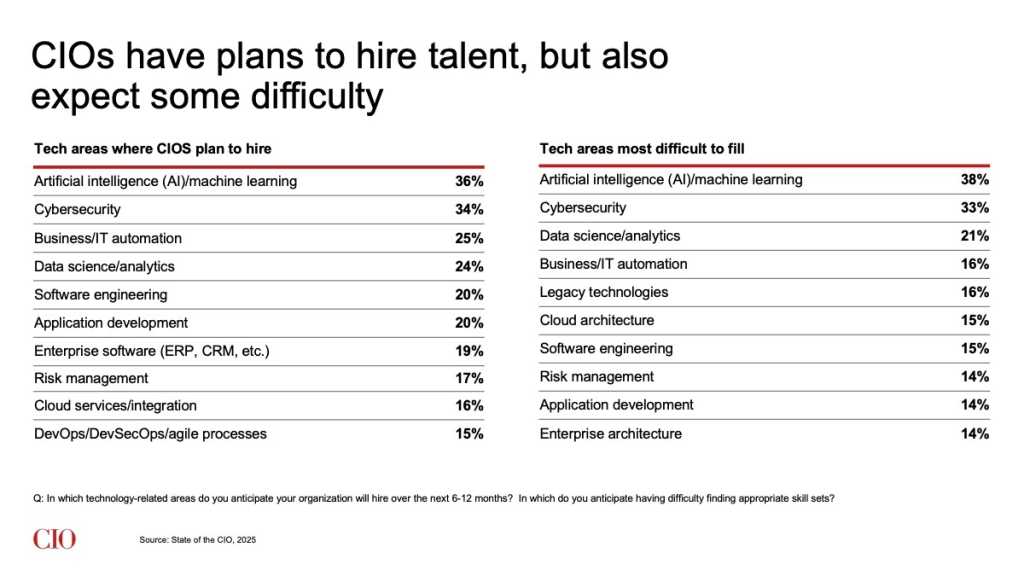
CIO.com
CIOs continue to gain ground as business leaders
Given the import of AI and the focus on business strategy, the CIO role continues to gain in stature. Three quarters of IT respondents pointed to the combination of economic factors and growing enterprise visibility as factors that continue to elevate the CIO position. CIOs are also getting more comfortable with multi-title roles and responsibilities, and the vast majority (77%) have forged a strong educational partnership with the CEO and board of directors. Half of respondents say the CIO is now the go-to executive for identifying new business opportunities in addition to making technology vendor recommendations.
As in past years, the CIO charter continues to be more digital and innovation focused, a direction cited by 82% of IT respondents. Similarly, 82% of this year’s respondents said CIOs lead digital transformation initiatives more so than their business counterparts. In roughly a quarter of companies (26%), the CIO holds sole responsibility for all digital transformation decisions and initiatives.
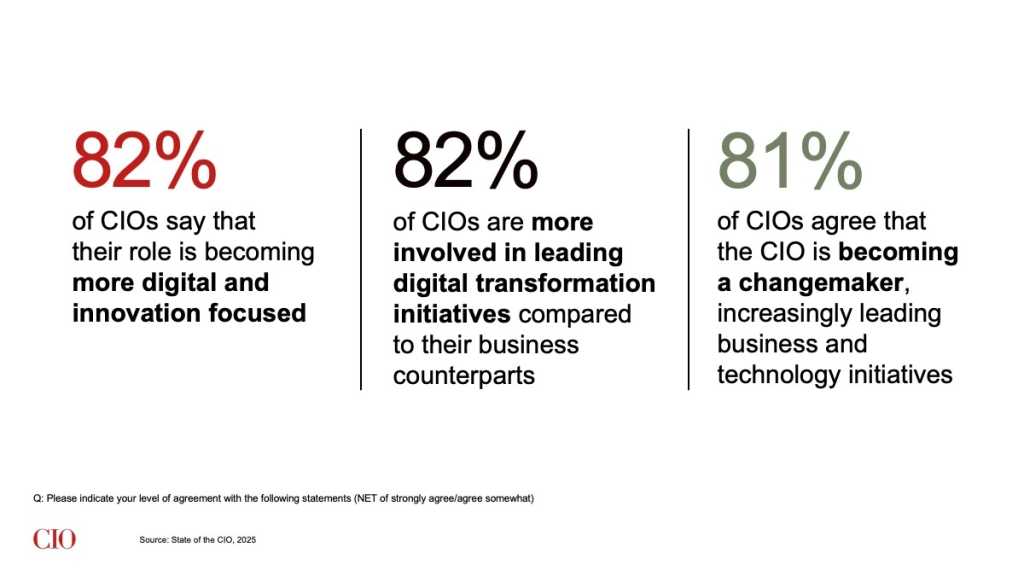
CIO.com
As experimental and production-grade AI initiatives take root, CIOs are ramping up their role as change makers and educators. According to the 2025 State of the CIO research, 81% of IT leader respondents categorized their role as change makers, responsible for championing both business and technology initiatives. Wearing multiple hats continues to be a challenge — roughly three quarters (76%) of respondents said striking the right balance between business innovation and operational excellence is a difficult juggling act.
Given the high stakes of this next AI chapter, Monica Caldas, executive vice president and CIO at Liberty Mutual, believes the CIO role is morphing yet again, this time into something she calls a “mass orchestrator.”

Monica Caldas, EVP and global CIO, Liberty Mutual
Liberty Mutual
“The fundamental shift for CIOs is being a mass orchestrator of expertise and people,” she explains. “You can’t just be a technology leader deploying technology, you have to be a technology leader that can deploy capabilities, understand the business, and orchestrate the right team to help navigate through everything in a way that makes sense for the business.”
[ Download the State of the CIO Research here. ]
Read More from This Article: State of the CIO, 2025: CIOs set the AI agenda
Source: News

